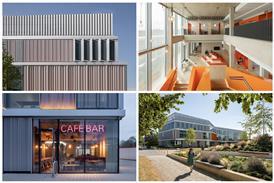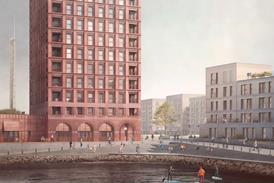Covid-19 has exposed many uncomfortable realities but it has also shown what can be achieved in a very short time, writes Julia Park

Homes, health and covid-19, a report published by the Centre for Ageing Better last September, makes sobering reading. A collaboration with The King’s Fund, it looks at the links between poor housing and poor health through the lens of the coronavirus.
There has never been much doubt about the existence of these links, but the strength of the correlation and the depth of the regional and local disparities are a stark reminder that, without radical action, the inequalities that covid-19 has revealed and exacerbated will only worsen.
The King’s Fund authors present compelling evidence about the extent to which our homes affect our physical and mental wellbeing. A YouGov survey commissioned by the National Housing Federation (NHF) in June, and referenced in the report, found that nearly a third (31%) of adults in Britain had mental or physical health problems during the first lockdown because of the size or condition of their home.
More than half of those who said that their homes weren’t big enough reported ill health, and over 5% said that this had led them to take medication or seek medical help for problems with their mental health.
An astonishing one in eight households in Britain has no access to a private or shared garden and, in England, black people are nearly four times as likely as white people to have no access to outdoor space at home
An analysis of the latest English Housing Survey reveals that 3.7m people, including 1.6m children, were living in overcrowded homes during the first lockdown: both are record figures. 30,000 people were living in a home consisting of one room, more than 3,600 children in a home with just two rooms and 62,580 families in temporary accommodation: the highest for 13 years.
An astonishing one in eight households in Britain has no access to a private or shared garden and, in England, black people are nearly four times as likely as white people to have no access to outdoor space at home (37% versus 10%). For the third time in under a year, the majority of them will be confined to their home for all but an hour or two a day.
The vaccine offers a way out of the pandemic, but not out of our housing problems. In the first lockdown covid-19 was new and relatively few jobs were lost. When we finally emerge at least two lockdowns later, it will be to a significantly worse situation than that described in the statistics above. Hence the need for radical action.
The single most important intervention has to be a huge increase in social housing. In A Vision for Social Housing, a compelling report produced at the start of 2019, Shelter called for 3.1m new social homes to be delivered over the next 20 years.
It is hard to know whether the political will is there, but funding is essential. 2021 must be the year that we crack land value capture.
The “hope value” embedded in the way that land is currently traded feels almost obscene at a time when so many people are desperately hoping just to keep their home and their job. If Robert Jenrick can manage to end ground rents in the middle of the worst month of the pandemic, he should be able to move onto land reform by the summer.
In 2014-15 (the most recent year I could find figures for), £9.3m of public money was paid to private landlords in housing benefit. At the time, the NHF calculated that, if all those housed in the private rented sector lived in affordable housing, it would save £1.5bn a year.
I suspect the bill is higher now and will continue to rise until we act. Reducing our reliance on the PRS to house those who cannot afford to buy would also alleviate the mental health impacts of unaffordable rents and insecure tenure.
>> Also read: Learning from lockdown: what needs to change in housing
When it comes to existing homes, Homes, health and covid-19 reveals that 18% of our stock (about 4.3m homes) is still classed as “non-decent”, with the highest percentage in the private rented sector. As 80-85% of our 23.5m homes will still be here in 2050, this is not something we can ignore, which is why the Centre for Ageing Better is supporting the “Good Homes Inquiry”.
Chaired by David Orr, it aims to bring together new and existing evidence, a range of stakeholders and the public to develop a consensus on what needs to change and how.
Energy efficiency is a key strand. We tend to forget that, while Part L has already made a significant difference, it is relatively new. Across all existing stock, taken together, cold and damp are still the biggest cause of housing-related mortality.
Housing is, of course, only one element of the recovery that cannot come soon enough – but it is among the most important
I hope that licensing for the private rented sector will also be among the outcomes. It is impossible to see unscrupulous landlords making the necessary improvements unless forced to do so, and councils simply don’t have the time to carry out regular inspections. We must look seriously at rent caps too.
Housing is, of course, only one element of the recovery that cannot come soon enough – but it is among the most important. Affecting every one of us every day of our lives, good housing is not just crucial in itself, it is also vital to acquiring the resilience to avoid, or cope with, problems in health, education, employment and social care.
When ministers are able to stop running around like headless chickens, they must adopt a more agile and targeted fiscal response to problems, based on prevention not firefighting. We, and they, have known for years that poor housing costs the NHS in England at least £1.4bn a year and that every £1 spent on improving warmth in “vulnerable” households can result in £4 of health benefits.
Falls on stairs are the second most prevalent cause of death or serious injury within the home. I heard a health worker talk about the madness of waiting for a vulnerable person to trip on the loose, thread-bare stair carpet they cannot afford to replace, break a femur and be forced into care. It is a tragic but foreseeable chain of events that ends up costing tens of thousands of pounds – and all because “the system” doesn’t allow us to fund a new carpet for just a few hundred.
>> Also read: Covid 19 may force us to rethink how we design cities
I am conscious that much of this is familiar stuff, but that is most of the point I’m making. Policy makers know it, too, but have chosen to ignore it for decades.
Covid-19 has exposed many uncomfortable realities but it has also shown what can be achieved in a very short time. It has forced the government to throw out the rulebook, listen to experts and find the resources to tackle big problems. It has not always worked but, with a sustained effort and a less frantic timescale, we can see that systemic change is possible.
Postscript
Julia Park is head of housing research at Levitt Bernstein and Building Design’s 2020 Architect Leader of the Year
















1 Readers' comment